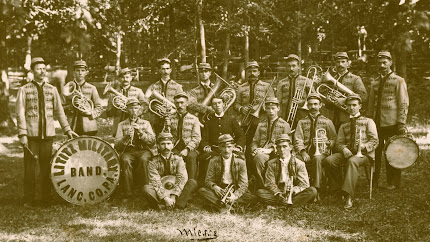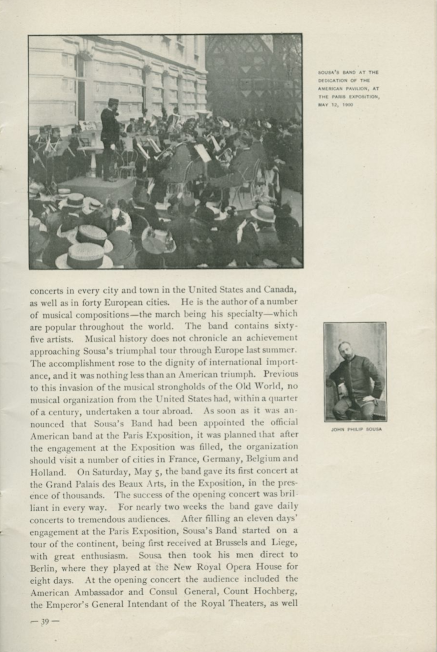John W. "Jack" Richardson (1874-1939) started working as a cigar maker in Rothsville, Pennsylvania, by at least the age of 19 or 20. Many small cigar factories were spread throughout Lancaster County in those days, so it is not surprising to discover that his first line of work was hand rolling cigars.
At the same time, Richardson started playing Eb bass in the Rothsville Cornet Band, followed by the Lititz Military Band, a few miles down the road, which was formed in late 1895, mostly of Rothsville Band members. Here's that band shortly after the time that Richardson played in it:
Two years later, in 1897, we find Richardson in Newark, New York (note, not New Jersey), working for George Croucher in his cigar factory, and playing in his newly formed "Cigar-Makers Band," officially named the Newark Band (see the photo at the top of this post, where Jack is in the middle of the back row holding a BBb helicon bass). It was while he was playing in this band that he chose to make music his career, and, apparently, picked up the nickname, "Big John" (Richardson was 6 feet 6 inches tall, or thereabouts, as you can see from the photo above!).
In the 1978 history of that region of New York, Annals of Arcadia, by Cecilia Jackson, we read the following:
Cigars in those early days were five cents and only a few reached the high price of ten cents. All were hand made. ... Newton Burrud and George W. Croucher were partners in one of the earliest of the cigar companies. They employed 20 men who were of Pennsylvania Dutch extraction, according to William Croucher, son of George Croucher. These men were all musicians and formed one of the first bands in town.
She then adds this:
Our present day band concerts were a direct result of the early band formed by those cigar makers. In those days the concerts were held from a band wagon at the four corners on Saturday nights. The cigar makers were musicians and three of them went on to play for Sousa, according to William Croucher. They were John Richardson, Arthur Bryer and Walt Shafer.
While there is no record of an Arthur Bryer ever playing with Sousa, Walt Sheaffer is said to have played Bb Clarinet on Sousa's 1911 world tour. But Richardson was with Sousa for twenty-two combined years (1904-1910, 1912-1917, 1923-1931). He was recruited by Sousa after obtaining much-needed professional experience with the 65th Regiment Band of Buffalo, New York (1900-1901), which performed at the Pan-American Exposition, and T. P. Brooke's Chicago Marine Band (1902-1903).
But for the purposes of this post, I simply want to note that when Sousa passed away in early 1932, which understandably led to Sousa's band disbanding, Richardson chose to retire to Steelton, Pennsylvania, the home town of his youngest brother, James Thomas Richardson, and return to his first love, so to speak. He purchased a cigar store there. Here's what I've learned about that . . .
"Jack Richardson's Cigar Store" opened at 2 South Front Street on August 19, 1933, directly across from the stately Peoples Bank (built in 1920). It was a prime location, at the corner of Front and Locust. Richardson had purchased the store from the estate of Robert H. Fairlamb, who had died suddenly of a heart attack, at age 45, about a month earlier.
Robert H. had come to own the store when his father, Robert V. Fairlamb, suddenly died in 1921, at the age of 61. The obituary for the latter reveals that he had been in the tobacco business (and other interests) in Harrisburg and Steelton for the previous 35 years. Prior to that, he had worked at the Steelton Post Office for a time, which, interestingly, was in the very same space that became Jack's Cigar Store in 1933. Here's a photo, reportedly from 1871 (the corner unit on the right):
While the elder Fairlamb had maintained a cigar store for years in Steelton on Market Street, by 1902, if not a bit earlier, he had another cigar shop at 1 South Front Street, directly across from where the post office was (or had been). Here's an old postcard, created by Fairlamb, showing his shop at that location (note the brown sign on the right, at the corner, hanging over the sidewalk on a horizontal pole, that says "Cigars"):
When the plan for building the Peoples Bank was settled, Fairlamb moved his cigar store directly across the street, to 2 South Front St. (again, the old post office space), as noted in the August 1, 1919 edition of the
Harrisburg Telegraph:
Fourteen years later, in 1933, shortly after the death of Fairlamb's son, Richardson purchased the shop and slapped his well-known name on it:
I don't smoke, but if I was alive at that time, I would definitely have made a pilgrimage to that cigar store to talk to the owner and get him sharing stories about his time with Sousa!
As it turned out, barely five years later, Richardson was in the hospital, reportedly related to his struggles with arthritis (but bone cancer may have been an issue as well), and he never went home again. Entering the Geisinger Memorial Hospital in Danville, PA, on May 5, 1938, he was eventually transferred to the Keystone Hospital in Harrisburg, where he passed on August 12, 1939.
I wonder if he enjoyed one last smoke of a 5-cent hand-rolled cigar?
Oh, and that building, where Jack had his cigar shop for those handful of years, remains standing today. It currently houses a skateshop, according to Google maps!
* * *
One last bit of trivia to include here, having to do with Fairlamb the elder, as it adds some color to his career back in those early days of the twentieth century. This is from the January 16, 1902 edition of the Harrisburg Daily Independent:



.png)




.png)
























.png)

























